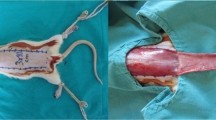Abstract
Oxygen-derived free radicals have been implicated in the causation of cellular injury during low-flow ischemia and during reperfusion of previously completely ischemic tissue; they are also believed to be the causative factor in the no-reflow phenomena. Modulation of these free radical substances has been suggested as a means of decreasing the amount of tissue loss due to ischemia and subsequent reperfusion. Pretreatment of tissues with a variety of agents has been reported to minimize the production of oxygen radicals and augment tissue survival after an ischemic insult. Further evidence of free radical involvement in skin flap necrosis in a rat groin island skin flap model is presented. In addition, the effects of two different free radical scavengers, alpha tocopherol (20 mg/kg intraperitoneally once daily for a week) and ginkgo biloba (5 mg/kg orally twice a day for a week) have been investigated and compared. Since malonyldialdehyde (MDA) is the end product of lipoperoxidation which occurs in cellular membranes in an ischemic period - dependent manner, MDA levels in tissue homogenates were measured 60, 90, and 120 min after an ischemic insult. MDA levels significantly increased in a time-dependent manner during the ischemic period in the control group. Results from the determination of tissue MDA levels at biopsy sites of radical scavenger treated groups compared with the placebo group showed that the ginkgo biloba-treated rat samples had significantly lower MDA levels than control samples only at the 120 min ischemic period (p<0.01). However, protection of lipoperoxidation in alpha tocopherol-treated rat samples was detected after both the 90 and 12 min ischemic periods (p<0.01), and the magnitude of these decreased MDA levels in alpha tocopherol-treated samples was found to be greater than it was after ginkgo biloba treatment. Decreasing free radicals during reperfusion by using these agents, preferably alpha tocopherol, may be beneficial in modulating the no-reflow phenomenon and subsequent reperfusion injury, and may help to improve tissue salvage.
Similar content being viewed by others
References
Al-Timimi DJ, Dormandy TL (1977) The inhibition of lipid autoxidation by human caeruloplasmin. Biochem J 168:283
Angel MF, Mellow CG, Knight KR, McC O'Brien B (1989) The effect of desferoxamine on tolerance to secondary ischemia caused by venous obstruction. Br J Plast Surg 42:422–424
Angel MF, Narayanan K, Ramasastry SS (1987) Desferoxamine increases skin flap survival: additional evidence of free radical involvement in ischemic flap surgery. Br J Plast Surg 39:469–472
Angel MF, Ramasastry SS, Swartz WM, Basford RE, Futrell JW (1987) Free radicals: basic concepts concerning their chemistry, pathophysiology, and relevance to plastic surgery. Plast Reconstr Surg 79:990–996
Angel MF, Ramasastry SS, Swartz WM et al (1988) The critical relationship between free radicals and degrees of ischemia: evidence for tissue intolerance of marginal perfusion. Plast Reconstr Surg 81:233
Angel MF, Narayanan K et al (1986) The etiologic role of free radicals in hematoma-induced flap necrosis. Plast Reconstr Surg 77:795
Babiy AV, Gebicki JM (1990) Vitamin E content and low density lipoprotein oxidizability induced by free radicals. Atherosclerosis 81:175–182
Carp H, Janoff A (1979) In vitro suppression of serum elastase inhibitory capacity by reactive oxygen species generated by phagocytosing polymorphonuclear leucocytes. J Clin Invest 63:793–797
Chance B, Sies H, Bovouis A (1979) Hydroperoxide metabolism in mammalian organs. Physiol Rev 59:527
Clark RA, Stone PJ (1981) Myeloperoxydase catalysed inactivation of alpha-1-protease inhibitor by human neutrophils. J Biol Chem 256:3348–3353
Darley-Usmar VM, Stone D, Smith DR (1989) Oxygen and reperfusion damage: an overview. Free Rad Res Comms 7:247–254
DelMaestro RF (1980) An approach to free radicals in medicine and biology. Acta Physiol Scand [Suppl] 492:153
Dormandy TL (1978) Free radical oxidation and antioxidants. Lancet I:647
Flores J (1972) The role of cell swelling in ischemic renal damage and the protective effect of hypertonic solute. J Clin Invest 51:118
Fridowich I (1978) The biology of oxygen radicals. Science 201:875–880
Green CJ, Dhami L (1989) The effect of deferrioxamine on lipid peroxidation and survival of ischemic island skin flaps in rats. Br J Plast Surg 42:565–569
Halliwell B (1974) Superoxide dismutase, catalase and glutathione peroxidase: solutions to the problems of living with O2. New Physiol 73:1075
Halliwell B (1978) Biochemical mechanism accounting for the toxic action of oxygen on living organisms: the key role of superoxide dismutase. Cell Biol Int Rep 2:113
Halliwell B, Gutteridge JM (1989) Free radicals in biology and medicine. In: Free radicals in biology and medicine. Clarendon, Oxford
Im MJ et al. (1984) Effect of allopurinol on the survival of hyperemic island skin flaps. Plast Reconstr Surg 73:276
Izquerdo R, Swartz WM, Sutker KB, Boydell CL (1992) Attenuation of reperfusion-induced lipoperoxidation by systemic use of oxygen radical scavengers after pedicle occlusion. Ann Plast Surg 28:175
Jennings PE, Jones AF (1987) Free radical reaction products in diabetics with microangiopathy. Diabet Med 4:452–456
Kerigan CL (1983) Skin flap failure: pathophysiology. Plast Reconstr Surg 72:766
Manson PN, Athenelli RM, Im MJ (1983) The role of oxygen free radicals in ischemic tissue injury in skin island flaps. Ann Surg 198:87
Manson PN et al (1986) Improved survival in free skin flap transfers in rats. Surgery 90:211
Mason A, et al (1981) Free radicals in pharmocology and toxicology: selected topics. Pharmacol Rev 33:189
Mascio P, Murphy ME (1991) Antioxidant defense systems: the role of carotenoids, tocopherols and thiols. Am J Clin Nutr 53:194
McCord JM (1985) Oxygen derived free radicals in post ischemic tissue injury. N Engl J Med 312:159
Ohkawa H, Ohishi N, Yagi K (1979) Assay for lipid peroxides in animal tissues by thiobarbituric acid reaction. Ann Biochem 95:351–358
Otamiri T (1989) Oxygen radicals, lipid peroxidation, and neutrophil infiltration after small intestinal ischemia and reperfusion. Surgery 105:593
Petry JJ, Wortham KA (1984) The anatomy of the epigastric flap in the experimental rat. Plast Reconstr Surg 74:410–413
Pryor WA (1978) The role of free radical reactions in biological systems. In: Pryor WA (ed) Free radicals in biology. Academic Press, New York
Reivich M (1983) Pathophysiology of cerebral ischemia. In: Harrison MJG, Dyken MK (eds) Cerebral vascular disease. Butterworths, London, p 86
Saran M, Bors W (1990) Radical reactions in vivo — an overview. Radiat Environ Biophys 29:249–262
Sinclair AJ, Barnett AH, Lunec J (1990) Free radicals and antioxidants in health and disease. Br J Host Med 43:334–342
Stroke PF, Majno G (1969) Microvascular changes in acutely ischemic rat muscle. Surg Gynecol Obstet 129:1213
Author information
Authors and Affiliations
Rights and permissions
About this article
Cite this article
Deveci, M., Dibirdik, I., Çeliköz, B. et al. Alpha-tocopherol and ginkgo biloba treatment protects lipid peroxidation during ischemic period in rat groin island skin flaps. Eur J Plast Surg 20, 141–144 (1997). https://doi.org/10.1007/BF01002048
Issue Date:
DOI: https://doi.org/10.1007/BF01002048




